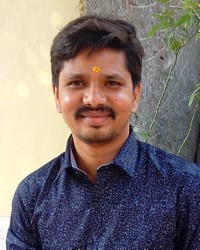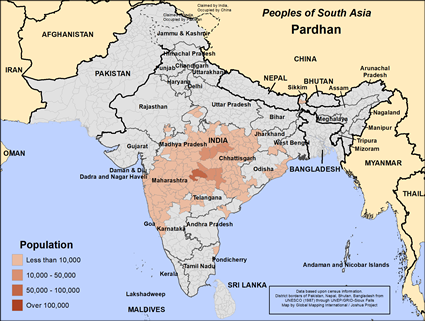Pardhan in India

Photo Source:
Anonymous
|

Map Source:
People Group data: Omid. Map geography: UNESCO / GMI. Map Design: Joshua Project.
|
| People Name: | Pardhan |
| Country: | India |
| 10/40 Window: | Yes |
| Population: | 320,000 |
| World Population: | 320,000 |
| Primary Language: | Pardhan |
| Primary Religion: | Hinduism |
| Christian Adherents: | 0.15 % |
| Evangelicals: | 0.00 % |
| Scripture: | Portions |
| Ministry Resources: | No |
| Jesus Film: | Yes |
| Audio Recordings: | Yes |
| People Cluster: | South Asia Tribal - other |
| Affinity Bloc: | South Asian Peoples |
| Progress Level: |
|
Introduction / History
The Pardhan are a subgroup of the Dravidian, tribal Gond people who live in central India. The traditional occupation of the Pardhan is that of being singers and musicians at festivals and important life ceremonies. Most Pardhan today are agricultural workers who cultivate wheat, sorghum, vegetables and fruit. Some also make their living by weaving and producing bamboo articles.
When the Aryans migrated into the Gond lands, some Gond submitted to their rule while other groups fought them only to be defeated by superior Aryan military technology. The Pardhan became the servants and slaves of the Aryans. As a tribal people they were considered outside the Hindu system and therefore outcastes.
The Pardhan are a Scheduled Casted meaning they receive special treatment in public jobs and university admission. Many Pardhan possess only a minimum of education so the India government is working to alleviate the problem.
The primary language of the Pardhan people is their own Pardhan language. Some Pardhan also speak Hindi, Marathi and Gondi
Where Are they Located?
The large majority of the Pardhan live in the Indian states of Maharashtra and Madhya Pradesh.
What Are Their Lives Like?
The Pardhan musicians have prodigious memories. Often they can recite hour-long epics and genealogies from memory in two or more languages. The two instruments they play are the kingri, a three stringed violin and a small harp called a bana. The Pardhan perform at births, weddings, funerals and Hindu holidays. The money they receive is donations from the participants. The Pardhan also function as Hindu priests in blessing babies and animals. Most Pardhan live in rural villages while some have moved to cities.
The Pardhan marry within their caste but not in their own clan or gotra. Families arrange marriages. The newly wed couple lives with or near the groom's parents. Sons inherit property with the eldest son taking the family house.
The main foods of the Pardhan are sorghum, wheat, vegetables and fruit. Due to their economic plight, meat and rice are eaten only on special occasions.
What Are Their Beliefs?
The Pardhan practice Hinduism, the ancient religion of India. They worship and serve the gods of the Hindu pantheon. Hindus believe that by performing rituals and good works that they will attain moksha or freedom from the endless cycle of birth, death and rebirth. The Pardhan visit Hindu shrines and offer prayers, food, flowers and incense to their gods. Sometimes they are denied entrance to Hindu temples due to their low class status.
The main yearly holidays of the Pardhan people are Holi, the festival of colors, Diwali, the festival of lights and Navratri, the celebration of autumn.
What Are Their Needs?
The Pardhan need to hear the life-changing message of Jesus Christ in a way they can understand. They need help in learning new job skills and in educating their children. Agricultural experts could help them increase the crop yield of their farms.
Prayer Points
Pray for the Holy Spirit to work powerfully through those Christians ministering to the Pardhan people.
Pray for Pardhan families to be drawn to Jesus and to the Bible and away from their Hindu gods.
Pray for the Holy Spirit to give the Pardhan people love for God's Word and a desire to spread its influence.
Ask the Lord to raise up and send out a new generation of fruitful, multiplying Christians among the Pardhan.